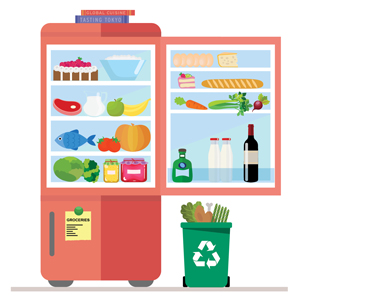
Let’s talk trash: Each year, 45 percent of all fruits and vegetables are tossed—the equivalent of 3.7 trillion apples and 1 billion bags of potatoes.
Per the Food and Agriculture Organization of the United Nations (FAO), enough food is wasted each year to feed 2 billion people, or six times the population of the United States. Food waste also is accelerating climate change; about 10 percent of all human-caused greenhouse gases are linked to uneaten food that ends up in landfills, according to FAO.
“The food system is complex. It used to be that communities only ate what they grew. Today, people don’t quite know where their food comes from. It just appears in front of them and when they’re done, it just disappears,” says Samantha Kenny, CAS/BA ’16, Kogod/MS ’17, program officer with World Wildlife Fund’s (WWF) food waste initiative. “There’s a huge opportunity for change.”
And Kenny’s not afraid to get her hands dirty.
As an AU student, she worked on waste management projects for the Offices of Sustainability and Zero Waste. Now at WWF, she’s working with the American Hotel and Lodging Association to measure food waste and develop strategies to curb it. US hotels serve $35 billion worth of food each year—so Kenny and the team have an opportunity to take a big bite out of the problem. “Looking at hotels gives us a foot in the door with the larger food service industry,” including restaurants and caterers.
Despite the enormity of the challenge—30 percent of the planet’s food, or 1.3 billion tons, is trashed every year—Kenny is hungry for the future.
“I’m working on a question that doesn’t have an answer yet, but I’m excited by the impact it could have on people and the planet.”
Kenny's tips for shopping and cooking smarter—and wasting less:
- Designate a shelf in the fridge for food that needs to be eaten within a week.
- Research recipes from around the globe: Often one food culture’s trash is another’s delicacy.
- Search for “kitchen sink” recipes to use up what’s in the fridge. Quiche, stir-fry, and soup are good options.
- Throw meat nearing its “sell by” date in the freezer. You can disregard dates for items like honey, which never goes bad.
- Buy frozen seafood to maintain its quality longer. Fish are often frozen during transport, only to be thawed for retail display.
- Freeze bananas and apples—among the most wasted fruits—to use later in baked goods or smoothies. Veggies can be used for broth, which is also freezer-friendly.
- Shop more often and buy less if you live near the store. If you live far away, make one big trip per week.
- Make a shopping list to curb impulse buys and don’t go to the store hungry.
- Bring your waste to a local compost collection site. Or get a backyard compost bin or worm farm to turn food scraps into fertilizer.